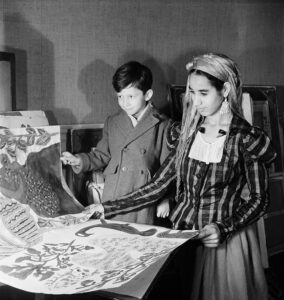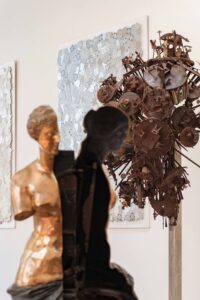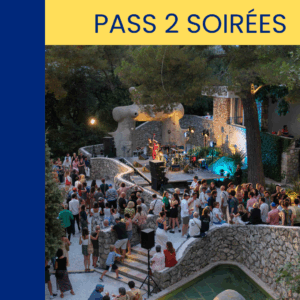
Miró Labyrinth
The Kite (1963) and The Lizard (1963) are found on the highest terrace in ceramic. Each on a wall, one is anchored and the other climbs like a gecko (a lucky charm in the Midi). Its irregular surface shows finger marks, those of Miró himself! The Tower (1963), in which three rounded ceramic plaques are embedded, is dominated by a cast iron bird one metre thirty high, perched at the top. The upper plaque is black with Miro’s emblematic black star drawn in graffiti, the one in the middle is white and has a complex drawing partly formed in curves, whereas the lowest is red with a sort of black cross and a circle in the centre. The Wall (1968), at the bottom of this structure, has 468 ceramic plaques with the same dimensions joined together like tiling and assembled like a puzzle. This ceramic wall of 12 metres by 2 was prepared in Spain, at Gallifa in the workshop of Artigas, then transported to and laid at the Foundation in 1968. The Goddess (1963) stands majestically at the centre of this terrasse, a goddess of fertility. Her fertile stomach is made up of a ceramic tortoise shell. A green gargoyle (1968) spews water into a first pool (the labyrinth has four), the background of which is animated with Miró’s creations. The Bow (1963) is presented on this second terrace, like a door open to another place. Made using 30 tonnes of concrete, it majestically takes centre stage and imposes its power to the ensemble. The artist, who always loved working with new materials and techniques, used a pneumatic drill to engrave the rough surface of this reinforced concrete sculpture! The Mammoth Egg (1963) is reflected on the water, all Miró’s poetic universe is present in a few engraved lines. The Sundial (1973) designed in broken ceramic seems to have stopped time. The Pitchfork (1963) is made in iron and bronze; it takes on the symbol of the farmer’s lifted fist, rebelling during the Spanish war. The pitchfork originally turned when the Mistral blew… today it has been immobilised. Several steps lower down, there is a white marble sculpture, The Woman with her Hair Down (1968), is placed on a rock, at the centre of the pool. Attached to the brick wall, the Totem-figure (1968), a face of brown ceramic perched on a high iron support, this figure with no body or arms looks over le Labyrinth, as a mysterious sphinx. The Lunar Bird and the Solar Bird (1968) are in Carrara marble, the latter placed on a stone base moves between taking the form of a marine mammal and a migratory bird. A Figure and two Gargoyles (1968) have been placed in the last pool. One of the three sculptures spews water. It is attached to the stone wall, next to two ceramic ancient theatre masks, one with a reptile’s head, the other with the round head of an owl.
Joan Miró (1893-1983)
This set of unique works, specially designed for the Fondation Maeght, used the different materials that Miró liked to work with: ceramics, Carrara marble, iron or bronze and concrete. The discovery of the Miró labyrinth, the creation of which continued well after the foundation was inaugurated (1963-1968-1973), was part of a line painted in white winding its way through the low walls and representing Ariadne’s thread from Greek legend. The tour itself can be done in any direction.



